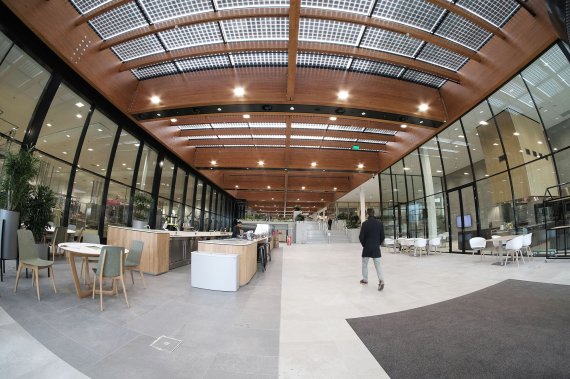Photos Guy Ackermans
You could call it a sneak peek at the neighbours. But that’s not really the right term, as you don’t have to be sneaky about it. Anyone can just walk in to Unilever’s brand-new Global Food Innovation Centre on the campus. That is the first thing that strikes you on entering the gigantic atrium with its solar roof. You can just walk in. No visible security, no gates, not even a receptionist at a counter to report to.
There is a ‘receptionist’ though: the hostess serving at the bar. The bar is the reception, explains press officer Sanne Snieder. ‘We consciously want to avoid a ‘corporate’ image here on the ground floor. So no receptionist sitting behind glass, and no security gates. We want to give off an aura of openness and transparency.’ There is the same hospitality in most of the spaces on the ground floor, including the company restaurant, which leads off the entrance. It is run by Eurest Compass, which also does the catering for the Friesland Campina next door. An interesting fact for students and researchers looking for a change at lunchtime. They are welcome, Snieder confirms.
Searching for answers
Unilever announced three years ago that it wanted to house its R&D activities on the campus. Until then, its research and development was spread over three locations: its head offices in Vlaardingen (Netherlands), Heilbronn (Germany) and Poznan (Poland). WUR came up as a suitable location for the new building and the desired collaboration, as it is the heart of the increasingly high-profile Food Valley. After Friesland Campina, Unilever is the second biggest food company to have moved its R&D to the campus.
‘The world is changing,’ is how R&D Food Transformation director Serpil Tascioglu explains the relocation. ‘The current food system is no longer adequate. The system is out of kilter, partly due to climate change and overpopulation.’ This conclusion led to the question: where next for the company? Unilever seeks the answer in collaboration – with universities, startups and other businesses in search of innovation. Tascioglu: ‘And in concentrating those activities at one location, in a building that stimulates collaboration and gives of an aura of openness to the outside world.’
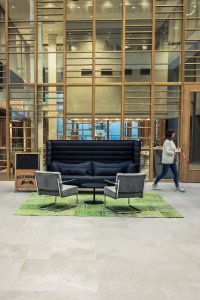
Forty per cent of the walls in the building are made of glass. That openness encourages internal collaboration and transparency. Photo Unilever
More than a PR pitch
The emphasis on openness, transparency and collaboration is more than a PR pitch. Unilever literally lets you see what it’s working on. In the large entrance hall, the visitor can see the factory to the left, where new concepts from the lab are tested on a factory scale. Through a vast wall of glass you can see what is going on behind it. To the right, a similar wall of glass provides a peak in the kitchen. This is the testing kitchen, the largest of five kitchens on the premises. The other four are behind the gates to the part of the building that is not open to the public.
Glass symbolizes the new openness and transparency, Tascioglu believes. ‘Forty per cent of the walls in the building are made of glass. That openness is not just towards people from outside; it also encourages internal collaboration among the 500 employees in the building. ‘You are more likely to run into each other,’ says Tascioglu. On the prominent and eye-catching wooden staircase in the middle of the hall, for instance, which connects the four storeys and invites you not to take the lift for a change. In fact, the lifts are deliberately tucked away in a corner of the hall.
*The prominent and eye-catching wooden staircase in the middle of the hall, for instance, which connects the four storeys and invites you not to take the lift for a change. Photo Unilever*Boosting collaboration
The appointment of Peter haring as Ecosystems Foods director underlines Unilever’s seriousness about openness and collaboration. His task is to crank up collaboration between Unilever and WUR. ‘In this context, ‘ecosystem’ refers to the ecosystem of companies and activities, with an emphasis on the campus,’ explains Haring. ‘WUR’s ambitions for sustainability largely match ours. The food system has got to change fundamentally. That calls for big steps. Not just in replacing animal products with plant-based ones, but also in terms of adding less salt, sugar and saturated fats to food products. So we are working a lot with the Agrotechnology & Food Sciences Group and the Plant Sciences Group. We have also had contact with several startups through Startlife.’
In practical terms, too, there is already plenty of interaction. An electron microscope of Unilever’s is located in Radix, and several NMR instruments in Helix. This is Unilever’s contribution to the shared research facilities envisaged by WUR. And while the move is going on, the company is renting laboratory space from WUR, as its own labs are not yet in use.
Global centre
‘The whole concept of collaboration is new,’ says Tascioglu. Staff are even being offered a training programme on collaboration. ‘Rather than trying to do everything yourself, we are joining forces and exchanging ideas with universities, students, startups and other companies. Together we want to make sure that Wageningen becomes the global centre for sustainable and healthy nutrition.’
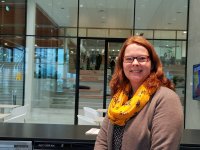
Food engineer Julia Kleine
‘As a foodie I feel quite at home here’
‘My favourite spot? The kitchen. The kitchens here are great,’ says food engineer Julia Kleine. ‘Although I’m not a cook, I am a foodie. And everything we do here is directly connected with the work of cooks and the way professional kitchens and consumers use our products.’ Kleine (38), from Germany, has been working for Unilever for 15 years, having started in Heilbronn after graduating from university in Berlin. After five years in Brazil, she came to Vlaardingen four years ago. And then came the bombshell that Unilever was moving to Wageningen. ‘I was dumbstruck,’ says Kleine honestly. ‘When I was working in Heilbronn, Vlaardingen where it all happened. That’s why I wanted to go there. But Wageningen? I didn’t know then that there was such a big university here.’ That has changed now. ‘Unilever organized several trips to Wageningen to have a look around. I got a good feeling about it.’ So Kleine and her husband, who works for Unilever too, started house-hunting. ‘We have two young children so commuting wasn’t an option. They found a house in Veenendaal. And Wageningen? ‘The building is fantastic. As a foodie, I feel quite at home here. The building fits what we want to be. We want to be open to the outside world. We want to be part of the ecosystem here.’
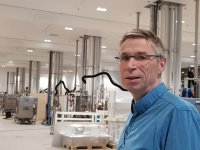
Process engineer Kees Montanus
‘Started with an empty box’
Kees Montanus has worked for Unilever for 38 years. His move to Wageningen has been a major transition, involving a career switch from Home & Personal Care to Foods. ‘Home and personal care moved to the UK due to a change in the organization, so I was mentally preparing myself for the possibility of moving there. Until they announced that everyone who wanted to move to Wageningen could do so.’
Montanus opted for Wageningen and was given the job of designing the new testing factory. ‘We started with an empty box. And this is what we ended up with,’ he says proudly, pointing at the prominent pilot plant to the left of the entrance hall. So he got to design his own factory? ‘Yes, that’s what it amounted to. In collaboration of course. Now the design phase is over, I am the manager of the testing factory.’ Montanus got straight on with his new life and now lives in Wageningen. ‘I saw a new-build project in Nieuw-Kortenoord. Houses in the 1930s style, just what I wanted. The house was ready in April this year. I love it here. The river and the woods, the liveliness of the town and the campus.’ And he is certainly happy with the new workplace too. ‘It is spacious and I think they used beautiful materials.’
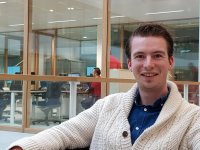
Management trainee Rik Stuart
‘I believe in the Food Valley ecosystem’
‘Nice, isn’t it, this building? It gives me so much energy every day when I come in here.’ Rik Stuart (26) has been a trainee at Unilever for 10 months, and has nothing but praise for his workplace. ‘It is very open and inspiring. You can look right into the kitchens and the testing factory through the glass. That gives people a good sense of what we are working on. Because of all the glass, you can see people at work everywhere around you. That makes you feel very connected.’ As a trainee, he is working on a three-year talent programme intended to lead to a first management job. It wasn’t a difficult decision to work for Unilever after a Wageningen degree in Biotechnology. ‘I always thought Unilever was a cool company. Especially because of their commitment to sustainability. And I’m a foodie: I love eating and cooking.’ A management traineeship was a less obvious choice. ‘I used to want an academic career. But I gradually realized that wasn’t really me.’ So here he is at Unilever, and back in Wageningen. ‘Very nice, actually, because I think it’s a great university. I am pleased we’ve moved here. I believe in the Food valley ecosystem.’ But he isn’t living here yet. ‘I’m not sure if I’ll stay here. The next phase of the training programme could be at another branch.’
Reuse and sustainability
The main materials in the building are glass, wood and metal: recyclable and therefore sustainable. Much of the wood used is already having a second life, even though it looks brand new. Much of the furniture in the building is second-hand, too. Which is to say, it has come from the old premises in Vlaardingen, Helibrunn and Poznan. Tascioglu: ‘We reused whatever we could.’ This attention for reusing things is part of a complete package of sustainability. The building is energy-neutral thanks to storage and 1800 solar panels. Rainwater is used for flushing the toilets. Infrared sensors continuously measure the temperature of ceilings, walls and floors so as to heat the building optimally. All this sustainable technology earned the building a BREEAM Award for sustainable construction in London last spring. The building can count itself the sustainability world champion in the business premises category.
Also read:
Unilever will share analysis equipment
Unilever provides Wageningen start-ups with lab access

